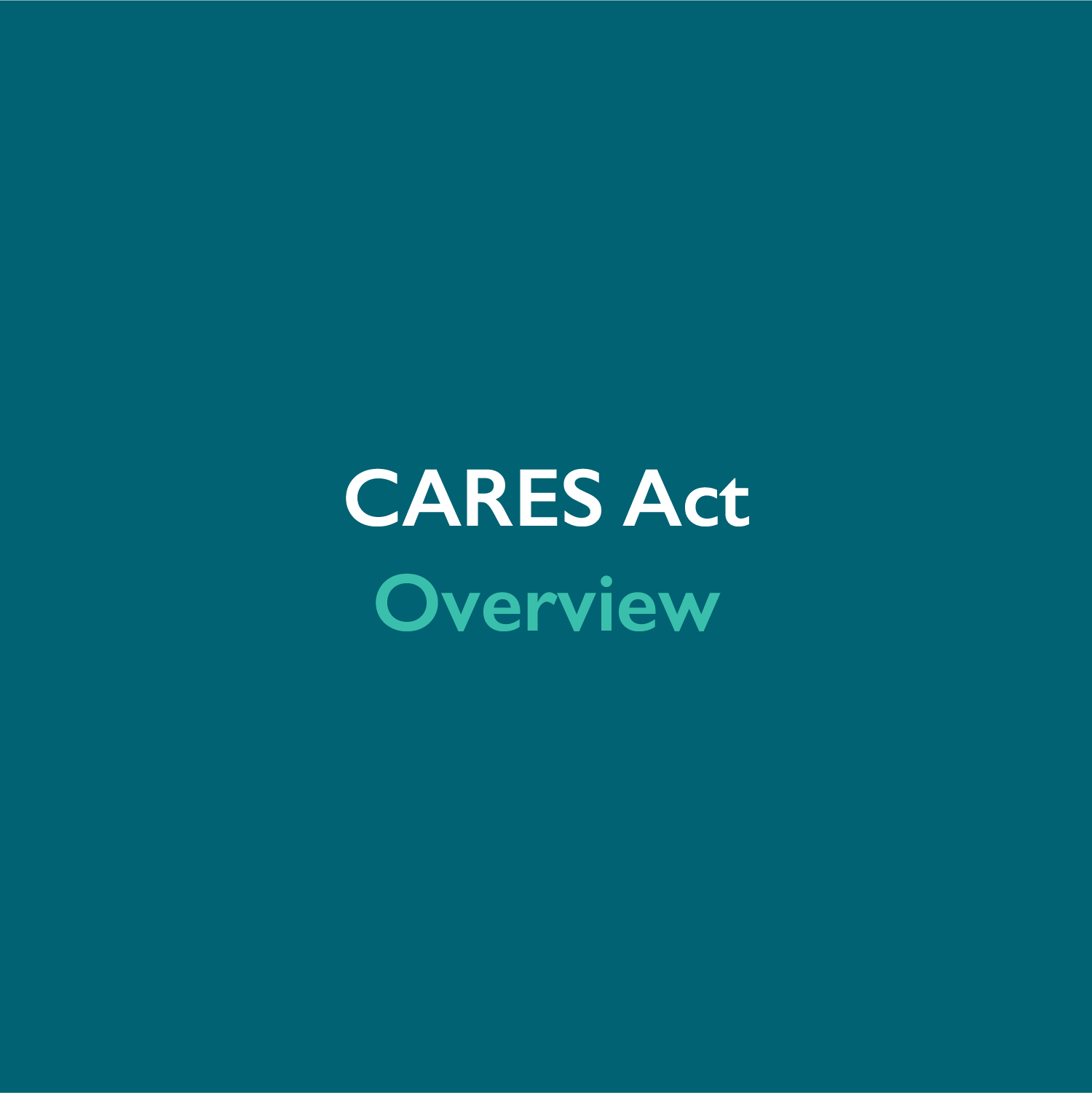4/28/2020 Update: A new $484 billion relief package, COVID 3.5, includes an additional $75 billion for hospitals, $25 billion to support testing efforts, $60 billion for emergency disaster loans and grants, and $320 billion in funding for the Paycheck Protection Program (which was established in the CARES Act) – $60 billion of which is reserved for community banks and small lenders.
On March 27, 2020, President Trump signed into law H.R. 748, the Coronavirus Aid, Relief, and Economic Security Act (“CARES Act” or the “Act”). Below is an overview of some of the key provisions. We will continue to monitor all provisions in the Act and update this post as needed.
Small Business Administration (“SBA”) Loans
- Small businesses, non-profits and individuals with 500 or fewer employees per location may seek an SBA loan of up to $10 million (up to 250% of average monthly payroll) under a new “Payroll Protection Program.”
- The covered loan period is February 15, 2020 through June 30, 2020.
- Loans may be used for payroll costs, including salaries, commissions, regular paid leave, health-care benefits, as well as mortgage payments, rent, utilities, and interest on other debts. Loan applicants will be required to make a good-faith certification that the funds will be used to retain workers, maintain payroll, and pay for eligible expenses.
- Loan proceeds cannot be used to compensate individual employees at an annual rate above $100,000.
- Rules requiring fees, collateral, personal guarantees, or certification that credit was unavailable elsewhere will be waived.
SBA Loan Forgiveness
- Payroll Protection Program loans may be eligible for forgiveness to the extent of the borrower’s payroll costs, mortgage interest, rent, and utility payments made during an 8-week period after the loan origination date.
- Loan forgiveness is reduced to the extent employees are laid off or salaries are reduced by more than 25%, but borrowers who rehire employees previously laid off will not be penalized for having reduced payroll at the beginning of the period.
- Canceled debt will be excluded from borrowers’ gross income for tax purposes.
SBA Disaster Loans
- The Act provides $10 billion to expand the SBA’s disaster loan program from January 31 through December 31 to cover businesses, cooperatives, employee stock ownership plans, and tribal businesses with 500 or fewer employees, as well as sole proprietors and independent contractors.
- The SBA will waive certain eligibility rules during the covered period for disaster loans made in response to COVID-19.
- SBA will be authorized to advance as much as $10,000 to existing and newly eligible disaster loan recipients within three days of receiving their applications. Recipients can use the advance funds to pay sick leave to employees affected by COVID-19, retain employees, address interrupted supply chains, make rent or mortgage payments, and repay debt. They won’t have to repay the advance funds.
Employee Retention Credit
- Established a refundable payroll tax credit of 50% of eligible wages paid by eligible employers to eligible employees during from March 13, 2020 through December 31, 2020 up to a maximum of $10,000 of compensation ($5,000 maximum credit per employee).
- Credit is available to employers if a government order related to the pandemic requires them to partially or fully suspend operations, or if their gross receipts have declined by certain thresholds.
- Employers with more than 100 full-time employees in 2019 will receive credits for wages paid to employees while they aren’t providing services. Employers with fewer employees will receive credit for wages paid while operations were suspended or during the quarter in which the company had a significant decline in gross receipts.
- Tax-exempt organizations are eligible for the credit.
- Employers can’t receive the credit if they receive a loan under the SBA Paycheck Protection Program.
- Employers can’t use the credit for wages taken into account for the paid leave credits established under the second coronavirus response law (Public Law 116-127).
Payroll Tax Deferral
- Deferral of employer’s share of 6.2% Social Security tax (includes self-employed individuals) through the end of 2020; deferred tax must be paid over 2 years (half by end of 2021 and remainder by end of 2022).
Leave Modification
- The emergency sick leave program enacted under the second coronavirus response measure is amended. Certain workers laid off on or after March 1, 2020, will be eligible to receive family leave benefits if they’re rehired.
- Caps on the amount employers will be required to pay per employee for the leave programs, are: $200 per day, or $10,000 total, for family leave related to care for a child whose school or day care has closed because of the coronavirus; $511 per day, or $5,100 total, for sick leave related to a worker’s quarantine or diagnosis; $200 per day, or $2,000 total, for sick leave related to caregiving for another quarantined individual or child whose school or day care has closed.
- The Treasury Department will waive penalties for employers failing to make payroll tax payments in anticipation of tax credits for the paid family and sick leave programs.
Net Operating Loss (“NOL”) Modifications
- NOLs arising from tax years beginning in 2018, 2019 or 2020 may be carried back 5 years.
- Temporary removal of 80% taxable income limitation for NOL deductions taken in 2018, 2019 and 2020.
- Can amend prior year returns if needed.
Stimulus Checks
- US residents with AGI up to $75,000 ($150,000 married filing jointly) are eligible for a rebate of $1,200 (or $2,400 if married) plus an additional $500 rebate per child.
- Stimulus checks are reduced by $5 for each $100 of income that exceeds threshold.
- Completely phases out when income exceeds $99,000 (or $146,500 for head of household, one child; or $198,000 married filing jointly with no children).
Unemployment Benefits
- An additional $600 per week in “federal pandemic unemployment compensation” will be available through July 31, 2020.
- Unemployment assistance may be for as long as 39 weeks including any week for which regular compensation or extended benefits are received.
- Available to individuals who are quarantined, caring for a diagnosed family member, or out of work because their employer closed due to the coronavirus. It also will be available to those who are self-employed, have limited work history, or otherwise don’t qualify for unemployment benefits. Benefits won’t be provided to individuals who can telework with pay or who are receiving other paid leave benefits.
- Benefit period applies retroactively to January 27, 2020 and will remain in place until December 31, 2020 with no waiting period.
- An additional 13 weeks of unemployment benefits will be available through the end of 2020 to help those who remain unemployed after state unemployment benefits are no longer available.
- States will be paid 100% of the total amount of unemployment benefits they provide, including administrative costs in certain cases, and will be fully reimbursed by the federal government for providing compensation during the first week of unemployment, without a waiting period.
- Payments will be made to states to reimburse nonprofits, government agencies, and Indian tribes for half the costs they incur through the end of 2020 to pay unemployment benefits.
- Funding will be provided to pay the cost of the first week of unemployment for states that choose to pay recipients as soon as they become unemployed instead of the 1-week waiting period.
Work-Sharing
- Funding will be provided to support “short-term compensation” programs, in which employers reduce employee hours instead of lay-offs; states may reimburse employers 100% of the costs incurred and employees may receive pro-rated unemployment benefits from the state.
Retirement Accounts
- Waives the 10% early withdrawal penalty for distributions of up to $100,000 from qualified retirement accounts for certain coronavirus related purposes made on or after January 1, 2020; income on distributions taxed over 3 years.
- Eligible individuals could receive loans for the lesser of $100,000 or the present value of their vested benefits in their employer retirement accounts in the 180 days after the bill’s enactment.
- Individuals affected by the coronavirus with retirement plan loans due by December 31, 2020, will have an extra year to repay them.
- Temporary waiver of required minimum distribution (“RMD”) rules for 2020 for certain retirement plans and accounts.
Charitable Contributions
- Above-the-line deduction of up to $300 of cash contributions to charities even for individuals who do not itemize.
- Increased limitations on charitable deductions for individuals (who itemize) and corporations.
- For individuals, the 50%-of-AGI limitation for cash contributions to a public charity is suspended for 2020; limited to 60%-of-AGI through 2025.
- For corporations, 10% limitation is increased to 25% of taxable income.
- Limitation on deductions for contributions of food inventory increased from 15% to 25% for 2020.
Student Loans
- Employees may exclude from gross income the amount of student loan repayment assistance received from employers, up to $5,250 annually, through December 31, 2020.
Qualified Improvement Property Amendment
- Businesses (especially in hospitality industry) can write off costs associated with improving facilities instead of having to depreciate them over 30 years.
Bankruptcy
- The measure allows businesses with as much as $7.5 million in debt to qualify for streamlined Chapter 11 bankruptcy, increasing the current debt limit of $2.73 million for eligible small businesses.
- For one year following enactment of the Act, federal payments related to the coronavirus will be excluded from income calculations under Chapter 11 bankruptcy proceedings.
- Allows debtors experiencing hardship related to COIVID-19 to modify existing bankruptcy reorganization plans.
Increased Interest Expense
- Repeals excess business loss limitation for pass-through entities and sole proprietors under Code Sec. 461(l) for 2018, 2019, and 2020 tax years.
Corporate Alternative Minimum Tax (“AMT”) Credits
- Accelerates ability for companies to recover corporate AMT credits.
Business Interest Expense Modifications
- Deductible amount of business interest expense under Code Sec. 163(j) increased from 30% to 50% of taxable income for 2019 and 2020.
- Taxpayers can elect to use 2019 taxable income to compute the interest limitation for 2020.
- These changes do not apply to partnerships for 2019, but 50% of excess 2019 interest limitation can be treated as paid or accrued by the partner in 2020.
____________________________________
We highly recommend you confer with your Miller Kaplan advisor to understand your specific situation and how this may impact you.



